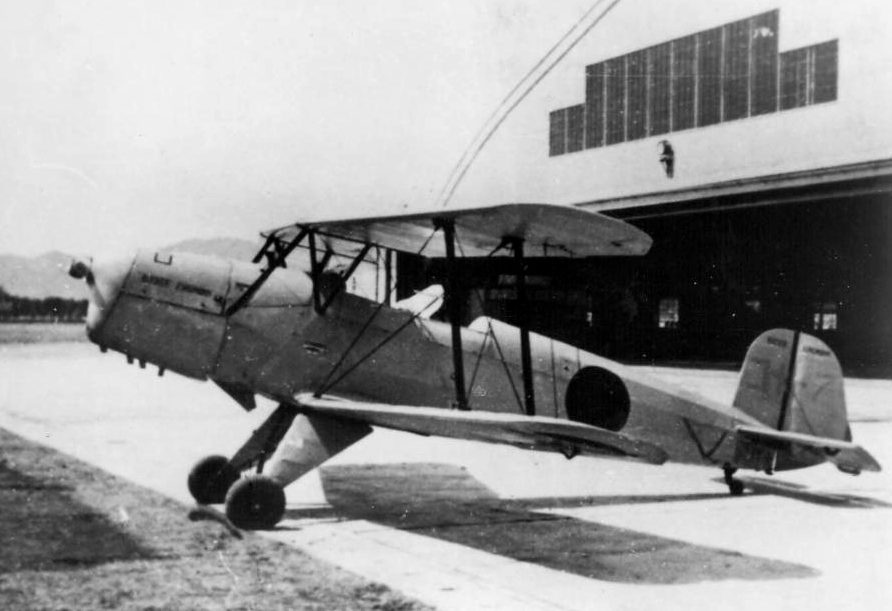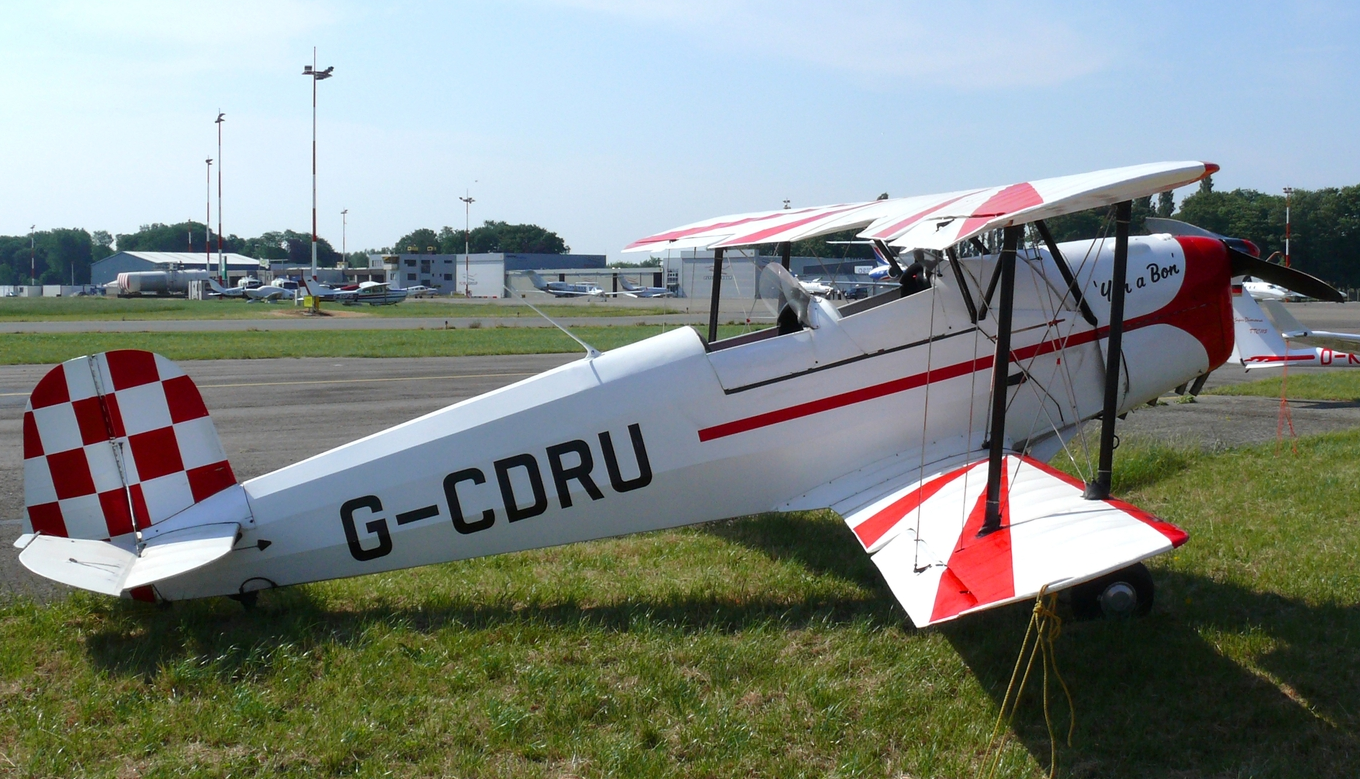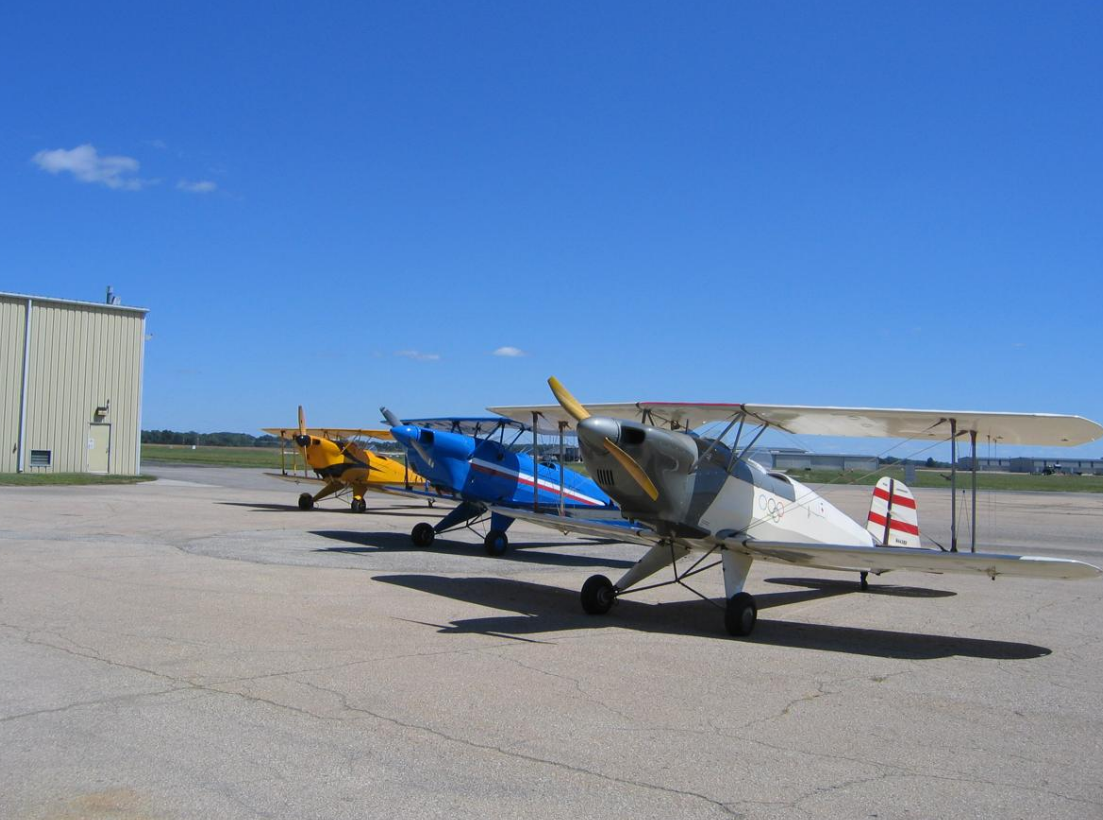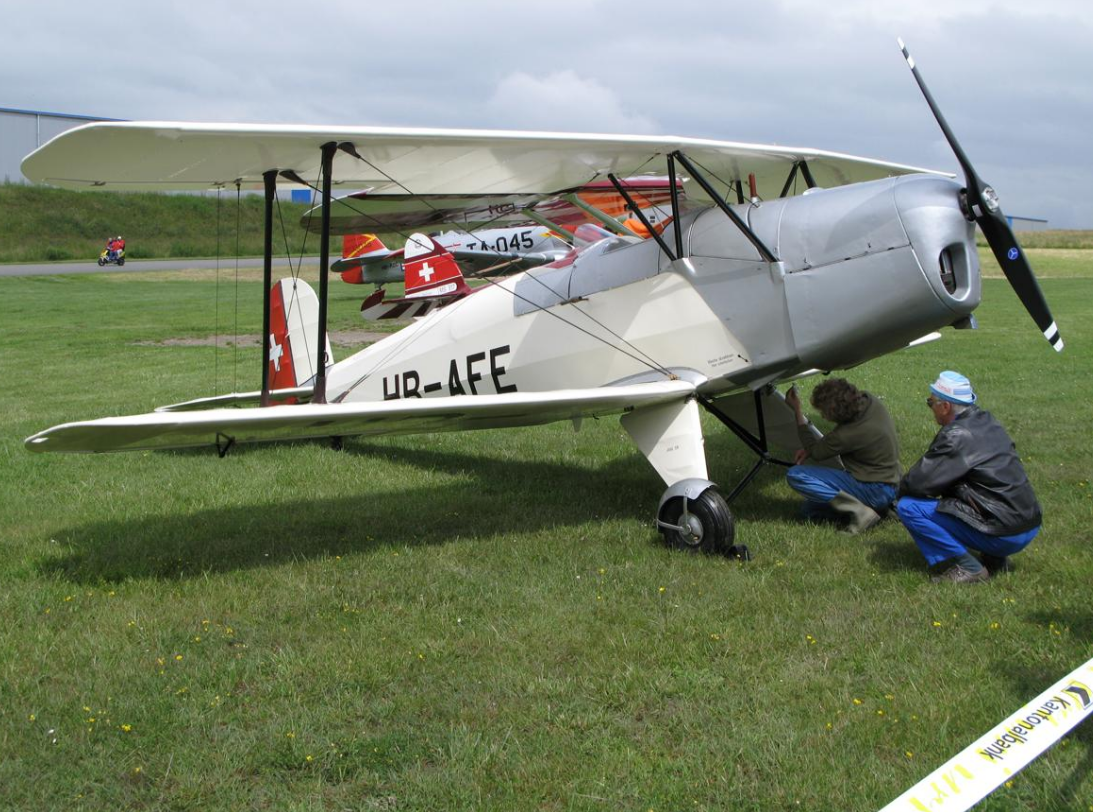The Bücker Bü 131 "Jungmann" (freshman, young man) was a German 1930s basic training aircraft which was used by the Luftwaffe during World War II.
- jungmann
- freshman
- basic training
1. Development
After serving in the Kaiserliche Marine in World War I, Carl Bücker moved to Sweden where he became managing director of Svenska Aero AB (Not to be confused with Svenska Aeroplan AB, SAAB). He later returned to Germany with Anders J Andersson, a young designer from SAAB. Bücker Flugzeugbau GmbH was founded in Berlin-Johannisthal,[1] in 1932, with the first aircraft to see production being the Bü 131 Jungmann.
While it was Bücker Flugzeugbau's first production type,[1] the Bü 131A was the last biplane built in Germany.[1] It had two open cockpits in tandem and fixed landing gear.[1] The fuselage was steel tube, covered in fabric and metal,[1] the wings wood and fabric.[1] It first flew on the 80 hp (60 kW) Hirth HM60R.[1]
In 1936, it was followed by the Bü 131B, with a 105 hp (78 kW) Hirth 504A-2.[1]
Most wartime production for the Luftwaffe was by Aero in Prague.[1]
2. Operational History

Sturdy and agile, the Bü 131A was first delivered to the Deutscher Luftsportverband (DLV).[1] The Bü 131B was selected as the primary basic trainer for the German Luftwaffe,[1] and it served with nearly all of the Luftwaffe's primary flying schools during the war, as well as with night harassment units such as Nachtschlacht Gruppen (NSGr) 2, 11, and 12.[1] Yugoslavia was the main prewar export customer; "as many as 400 may have found their way" there.[1] She was joined by Bulgaria with 15 and Romania with 40.[1]
Production licenses were granted to Switzerland , which operated 94, of which 88 were built under licence by Dornier.[1] About 530 were built in Spain [1] with production continuing at CASA until the early 1960s, and they remained in service as the Spanish Air Force 's primary basic trainer until 1968. Hungary operated 315,[1] while ten were built in Czechoslovakia by Tatra as the T 131, before World War Two.[1] In Japan , 1,037 were built for the Imperial Japanese Army Air Service with Hatsukaze engines as the Kokusai Ki-86 and 339 for the Imperial Japanese Navy Air Service as the Kyushu K9W.[1]
In the 1960s and early 70s the Spanish, Swiss and Czech governments sold their Jungmanns to private owners and many were exported to the United States. About 200 Jungmanns survive to this day, many having been fitted with 150 hp (110 kW) Lycoming O-320 or 180 hp (130 kW) O-360 four-cylinder horizontally-opposed engines with inverted fuel and oil systems for aerobatic flight.
The Jungmann is prized for its outstanding handling characteristics when compared to other antique bi-planes and even some modern aerobatic types. Upkeep and maintenance for the Jungmann is comparable to other antique aircraft and is superior when fitted with the Lycoming engines. Airframe parts are available from sources both in the United States and Europe.
In 1994, the Bü 131 was restored to production briefly using CASA jigs by Bücker Prado in Spain, with 21 aircraft constructed as the BP 131,[1] while in Poland SSH Janusz Karasiewicz also started production of a version of the Jungmann based on Czech plans in 1994.[2] 20 were manufactured in Poland between 1994 and 2000.[3]
3. Variants


- Bü 131A
- Two-seat primary trainer biplane. Initial production version.
- Bü 131B
- Improved version, powered by the more powerful Hirth HM 504A-2 piston engine.
- Bü 131C
- Experimental version, fitted with 90 hp (67 kW) Cirrus Minor piston engine. One built.
- Nippon Kokusai Ki-86A Army Type 4 Primary Trainer
- Japanese production version for the Imperial Japanese Army Air Service. Powered by a Hitachi Ha47
- Nippon Kokusai Ki-86B Army Type 4 Primary Trainer
- Wooden airframe version to relieve scarce supplies of strategic materials.
- Kyushu K9W1 Momiji Navy Type 2 Trainer Model 11
- Japanese production version for the Imperial Japanese Navy. Powered by the Hitachi GK4A Hatsukaze 11
- Tatra T.131
- Czechoslovakia, pre-war licence production in Tatra Kopřivnice.
- Aero C-4
- Mass-produced in Aero factory in occupied Czechoslovakia during wartime under original Bücker Bü 131B designation, used postwar with original Hirth engine.
- Aero C-104
- Czechoslovakia, postwar development with a Walter Minor 4-III engine, 260 built.
- CASA 1.131
- Spanish license-built versions
- BP 131
- modern license-built version
- SSH T-131P
- Pre-production modern Polish version, powered by 78 kW (105 hp) Walter Minor 4-III engine. Four built from 1994.[2]
- SSH T-131PA
- Main Polish production version, with 103 kW (138 hp) LOM M332AK engine. First flew 1995.[2]
4. Operators



- Bulgarian Air Force
- Czechoslovak Air Force
- Czechoslovakian National Security Guard
- Air Force of the Independent State of Croatia
- Luftwaffe
- Hellenic Air Force
- Royal Hungarian Air Force
- Imperial Japanese Army Air Service
- Imperial Japanese Navy Air Service
- Royal Netherlands Air Force
- Polish Air Force (1 bought for tests before 1939)[3]
- Royal Romanian Air Force
- Romanian Air Force
- Slovak Air Force (1939–45)
- South African Air Force
- Spanish Air Force
- Swiss Air Force
- Yugoslav Royal Air Force
- SFR Yugoslav Air Force
5. Specifications (Bü 131B)


(Polish Aviation Museum)
Data from Jane's Fighting Aircraft of World War II[4]
General characteristics
- Crew: 2
- Length: 6.62 m (21 ft 9 in)
- Wingspan: 7.4 m (24 ft 3 in)
- Height: 2.25 m (7 ft 5 in)
- Wing area: 13.5 m2 (145 sq ft)
- Airfoil: NACA 3410.5[5]
- Empty weight: 380 kg (838 lb)
- Gross weight: 670 kg (1,477 lb)
- Powerplant: 1 × Hirth HM 504 4-cylinder invertead air-cooled in-line piston engine, 75 kW (100 hp)
- Propellers: 2-bladed fixed-pitch propeller
Performance
- Maximum speed: 183 km/h (114 mph, 99 kn)
- Cruise speed: 170 km/h (110 mph, 92 kn) </br.
- Landing speed: 82 km/h (51 mph; 44 kn)
- Range: 650 km (400 mi, 350 nmi)
- Service ceiling: 4,300 m (14,100 ft)
- Time to altitude: 1,000 m (3,281 ft) in 5 minutes 12 seconds
-
-
-
- 2,000 m (6,562 ft) in 12 minutes
- 3,000 m (9,843 ft) in 23 minutes
- 4,000 m (13,123 ft) in 45 minutes
-
-
- Wing loading: 46.3 kg/m2 (9.5 lb/sq ft)
- Power/mass: 0.11957 kW/kg (0.07273 hp/lb)
The content is sourced from: https://handwiki.org/wiki/Engineering:B%C3%BCcker_B%C3%BC_131
References
- Ketle and Rolfe 1996, p. 12.
- Jackson 2003, pp. 344–345.
- Morgała, Andrzej Morgała (2003). Samoloty wojskowe w Polsce 1924–1939. Warsaw: Bellona, p. 316. ISBN:83-11-09319-9 (in Polish)
- Bridgeman 1946, p. 158.
- Lednicer, David. "The Incomplete Guide to Airfoil Usage". https://m-selig.ae.illinois.edu/ads/aircraft.html. Retrieved 16 April 2019.
